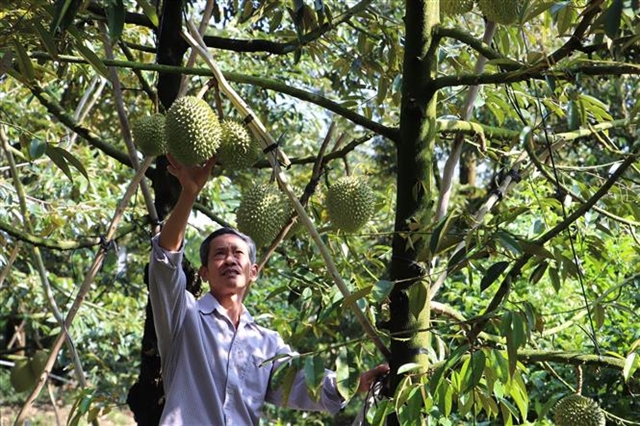This sharp decline has had a direct impact on Việt Nam’s fruit and vegetable export revenue, which stood at US$416 million in January 2025, marking a 11.3 per cent decrease month-on-month and a 5.2 per cent drop year-on-year.

HÀ NỘI — Việt Nam’s durian exports to China plummeted by 80 per cent in the first half of February 2025, with only 3,500 tonnes shipped, according to the Ministry of Agriculture and Rural Development (MARD).
This sharp decline has had a direct impact on Việt Nam’s fruit and vegetable export revenues, which stood at US$416 million in January 2025, marking a 11.3 per cent decrease month-on-month and a 5.2 per cent drop year-on-year.
The primary reason behind the export slump is China’s stricter inspection measures for imported durians, particularly regarding cadmium and Auramine O (Basic Yellow 2 - BY2) residues. These tighter regulations were introduced after violations were found in Thai durians.
From early 2025, China has mandated residue testing for all shipments in accredited laboratories, significantly prolonging export procedures. The delays in testing have disrupted delivery schedules, leading to congestion at border gates. Some traders have resorted to grey-market exports, but this approach is unsustainable for the long-term stability of Việt Nam’s durian industry.
Deputy Minister of Agriculture and Rural Development Phùng Đức Tiến acknowledged that China’s stricter controls were aimed at ensuring food safety, but also posed significant challenges for exporters and farmers. Phan Thị Mến, CEO of Sutech Science and Technology Consulting Co., Ltd., said that due to the strict inspections, export volumes have plunged and some days, no shipments could be processed.
Deputy Chairman of Lạng Sơn Province’s People’s Committee Đoàn Thanh Sơn emphasised that China had issued multiple warnings, urging Vietnamese exporters to improve quality control. However, many traders have yet to fully adapt, resulting in difficulties in meeting compliance standards.
Deputy Minister Hoàng Trung revealed that aside from the nine testing laboratories already recognised by China, six more have been submitted for approval to accelerate the export process. This effort comes as Việt Nam’s durian and other fruit harvests peak.
Việt Nam currently has around 169,000 hectares of durian plantations, more than double the area planned for 2030, which was estimated at 65,000–75,000 hectares. The proportion of durian plantations reaching harvestable maturity is also relatively high.
To address China’s additional food safety measures on Vietnamese fruit exports, MARD has instructed relevant agencies and local authorities to implement stricter quality management models. Particular emphasis is being placed on chemical use in plantations and packaging facilities to ensure compliance.
The Vietnamese Government is also negotiating with China to restore previous export regulations, aiming to ease inspection procedures and facilitate smoother customs clearance. Additionally, some exporters are seeking alternative markets to reduce over-reliance on China, ensuring a more stable and diversified export strategy for Việt Nam’s durians.
Previously, Taiwan’s Food and Drug Administration (TFDA) imposed a mandatory inspection on all fresh durian shipments from Việt Nam from August 12, 2024, to February 11, 2025 due to four failed quality tests within six months. — BIZHUB/ VNS





